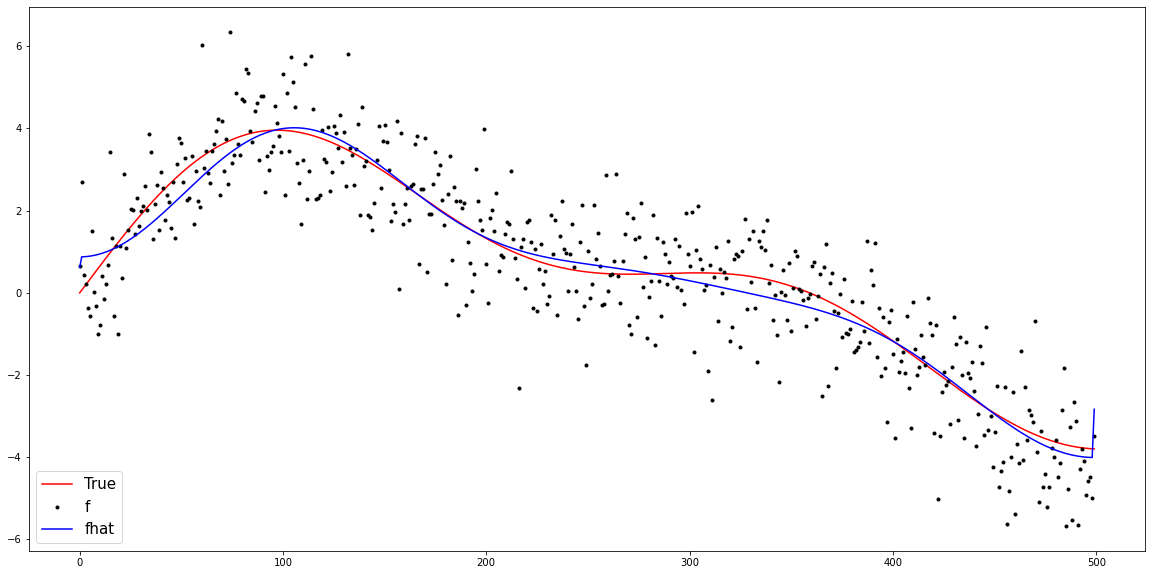from itstgcn.learners import * EbayesThresh Toy ex
Import
import numpy as np
import matplotlib.pyplot as plt
import random
import pandas as pdfrom rpy2.robjects.vectors import FloatVector
import rpy2.robjects as robjects
from rpy2.robjects.packages import importr
import rpy2.robjects.numpy2ri as rpyn
ebayesthresh = importr('EbayesThresh').ebayesthreshWhile \({\bf p}_y\) serves as a consistent estimator for \(\mathbb{E}[|{\bf V}^H{\bf y}|^2]\), it is not an efficient estimator, and therefore, improvement is needed [@djuric2018cooperative]. The traditional approach for improvement is to use the windowed periodogram.
The windowed periodogram is efficient in detecting specific frequencies or periods, but it may not be as efficient in estimating the underlying function. One notable paper that utilized the windowed periodogram is the one that detected the El Niño phenomenon.
As this structure exhibits a “sparse signal + heavy-tailed” characteristics, by applying Bayesian modeling and thresholding \({\bf p}_y\), we can estimate an appropriate \({\bf p}_{pp}\) as discussed in [@johnstone2004needles].
Bayesian Model
\(x_i \sim N(\mu_i,1)\)
확률변수가 잘 정의되어 있을때, 여기서 \(\mu_i\)를 정하는 Baysian.
- \(\mu_i \sim\) 사전분포(\(\mu_i\)를 뽑을 수 있는)
- \((\mu_i | X_i = x_i)^n_{i=1} \sim\) 사후분포
ex) \(N(10,1) \sim\) 사전분포
관측치
_obs = [7.1,6.9,8.5]np.mean(_obs)7.5관측치를 보니 평균이 10이 아닌 것 같다.
\(N(10-3,1) \sim\) 사후분포
- 여기서, \(10-3\)이 posterior meman
- 사후 분포를 정의할때, 이벤트의 mean이냐, median이냐로 잡는 방법은 정해진 것이 아니다.(이베이즈에서는 median으로 잡음)
Ebayes는 사전분포를 Heavy-tail으로 정의했다.
heavy tail?
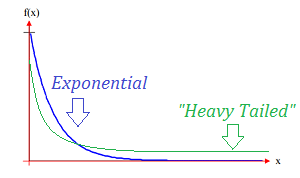
\(\mu_x \sim\) Double Exponential \(= p_{pp} + p_{ac}\) -> 혼합형(misture) = pure point + absolutely continuous
\(E(\mu_i | X_i = x_i) = \hat{\mu}_i\) -> thresholding의 결과
\(f_{prior}(\mu) = (1-w)\delta_0(\mu) + w \gamma (\mu)\)
- \(\delta_0\) = 디렉함수(특정값이 아니면 다 0으로 봄)
- \(\gamma = \frac{a}{2} e^{-a|\mu|}\)
Ebayes의 역할 = 자동으로 \(w\)를 계산 혹은 추정
- \(1-w\) 확률로 \(\delta_0\)를 정의, \(w\)의 확룔로 \(\gamma\)를 정의.
\(X_i = \mu_i + \epsilon_i, \epsilon_i \sim N(0,1)\)에서 \(\mu_i\)를 찾는게 목적이다. 이게 바로 \(\eta\)값
- Ebayes로 sparse signal만 골러낼 것이다.
- 평균 이상의 값에서 자를 것이다.
- thresh(임계치)를 잡는 게 어려울 텐데, 위에서 이베이즈가 \(w\)를 자동으로 잡아 확률 계산되는 방법론을 제안한 것,
- baysian modeling 사용하여 heavy tail + impulse(sparse)에서 posterior median 추정하여 임계값thresh으로 \(p\)에서 \(p_{pp}\)를 추출하는 것이 GODE 목적
EbayesThresh
T = 100t = np.arange(T)/T * 10y_true = 3*np.sin(0.5*t) + 1.2*np.sin(1.0*t) + 0.5*np.sin(1.2*t) y = y_true + np.random.normal(size=T)plt.figure(figsize=(10,6))
plt.plot(t,y_true)
- 관찰한 신호
plt.plot(t,y,'o')
plt.plot(t,y_true,'--')
- 퓨리에 변환
f = np.array(y)
if len(f.shape)==1: f = f.reshape(-1,1)
T,N = f.shape
Psi = make_Psi(T)
fbar = Psi.T @ f # apply dft plt.plot(t,fbar**2) # periodogram 
- threshed
fbar_threshed = np.stack([ebayesthresh(FloatVector(fbar[:,i])) for i in range(N)],axis=1)
plt.plot((fbar**2)) # periodogram
plt.plot((fbar_threshed**2)) 
plt.plot((fbar**2)[20:80]) # periodogram
plt.plot((fbar_threshed**2)[20:80]) 
- 역퓨리에변환
yhat = Psi @ fbar_threshed # inverse dftplt.figure(figsize=(10,6))
plt.plot(t,y,'.')
plt.plot(t,y_true,'--')
plt.plot(t,yhat)
plt.figure(figsize=(10,6))
plt.plot(y,'.')
plt.plot(y_true)
Result
with plt.style.context('seaborn-white'):
fig, ((ax1,ax2),(ax3,ax4)) = plt.subplots(2,2,figsize=(40,15))
fig.suptitle('Figure 1',fontsize=40)
ax1.plot(y, 'b.',alpha=0.5)
ax1.plot(y_true,'p--',label='True')
ax1.legend(fontsize=20,loc='upper left',facecolor='white', frameon=True)
ax1.tick_params(axis='y', labelsize=20)
ax1.tick_params(axis='x', labelsize=20)
ax2.plot(y, 'b.',alpha=0.5)
ax2.plot(y_true,'p--',label='True')
ax2.plot(yhat,label='y hat')
ax2.legend(fontsize=20,loc='upper left',facecolor='white', frameon=True)
ax2.tick_params(axis='y', labelsize=20)
ax2.tick_params(axis='x', labelsize=20)
ax3.plot((fbar**2)) # periodogram
ax3.plot((fbar_threshed**2))
ax3.tick_params(axis='y', labelsize=20)
ax3.tick_params(axis='x', labelsize=20)
ax3.axvspan(20, 80, facecolor='gray', alpha=0.2)
ax4.plot(range(20, 80),(fbar**2)[20:80]) # periodogram
ax4.plot(range(20, 80),(fbar_threshed**2)[20:80])
ax4.set_xticks(range(20, 81, 10))
ax4.set_xticklabels(range(20, 81, 10))
# ax4.set_xticklabels(['20','40','60'])
ax4.tick_params(axis='y', labelsize=20)
ax4.tick_params(axis='x', labelsize=20)
from mpl_toolkits.axes_grid1.inset_locator import mark_inset, inset_axes
plt.figure(figsize = (20,10))
plt.suptitle('Figure',fontsize=40)
ax = plt.subplot(1, 1, 1)
ax.plot(range(0,100),(fbar**2))
ax.plot((fbar_threshed**2))
axins = inset_axes(ax, 8, 3, loc = 1, bbox_to_anchor=(0.8, 0.8),
bbox_transform = ax.figure.transFigure)
axins.plot(range(20, 80),(fbar**2)[20:80])
axins.plot(range(20, 80),(fbar_threshed**2)[20:80])
axins.set_xlim(20, 80)
axins.set_ylim(-0.1, 7)
mark_inset(ax, axins, loc1=4, loc2=3, fc="none", ec = "0.01")
ax.tick_params(axis='y', labelsize=20)
ax.tick_params(axis='x', labelsize=20)
axins.tick_params(axis='y', labelsize=15)
axins.tick_params(axis='x', labelsize=15)
# plt.savefig('Ebayes_Toy.png')
from matplotlib.patches import ConnectionPatch
fig = plt.figure(figsize=(20,10))
plt.suptitle('Figure 1',fontsize=40)
plot1 = fig.add_subplot(2,2,(1,2))
plot1.plot(range(20, 80),(fbar**2)[20:80]) # periodogram
plot1.plot(range(20, 80),(fbar_threshed**2)[20:80])
plot1.set_xticks(range(20, 81, 10))
plot1.set_xticklabels(range(20, 81, 10))
plot1.tick_params(axis='y', labelsize=20)
plot1.tick_params(axis='x', labelsize=20)
plot3 = fig.add_subplot(2,2,(3,4))
plot3.plot((fbar**2)) # periodogram
plot3.plot((fbar_threshed**2))
plot3.tick_params(axis='y', labelsize=20)
plot3.tick_params(axis='x', labelsize=20)
plot3.axvspan(20, 80, facecolor='gray', alpha=0.2)
# plot3.fill_between((20, 80), 10, 60, facecolor= "red", alpha = 0.2)
conn1 = ConnectionPatch(xyA = (20, -0.1), coordsA=plot1.transData,
xyB=(20, 0), coordsB=plot3.transData, color = 'black')
fig.add_artist(conn1)
conn2 = ConnectionPatch(xyA = (79, -0.1), coordsA=plot1.transData,
xyB=(80, 0), coordsB=plot3.transData, color = 'black')
fig.add_artist(conn2)
plt.show()
In article
import rpy2
import rpy2.robjects as ro
from rpy2.robjects.vectors import FloatVector
from rpy2.robjects.packages import importr%load_ext rpy2.ipython%%R
library(GNAR)
library(igraph)R[write to console]: Loading required package: igraph
R[write to console]:
Attaching package: ‘igraph’
R[write to console]: The following objects are masked from ‘package:stats’:
decompose, spectrum
R[write to console]: The following object is masked from ‘package:base’:
union
R[write to console]: Loading required package: wordcloud
R[write to console]: Loading required package: RColorBrewer
import rpy2from rpy2.robjects.packages import importrebayesthresh = importr('EbayesThresh').ebayesthresh#import rpy2
#import rpy2.robjects as ro
from rpy2.robjects.vectors import FloatVector
import rpy2.robjects as robjects
from rpy2.robjects.packages import importr
import rpy2.robjects.numpy2ri as rpyn
GNAR = importr('GNAR') # import GNAR
#igraph = importr('igraph') # import igraph
ebayesthresh = importr('EbayesThresh').ebayesthresh%%R
set.seed(1)
x <- rnorm(1000) + sample(c( runif(25,-7,7), rep(0,975)))\(X_i\)에서 \(\mu_i\) 추출 가능하는 것을 증명할 예제
%%R
# png("Ebayes_plot1.png", width=1600, height=800)
par(mfrow=c(1,2))
par(cex.axis=2)
par(cex.lab=2)
plot(x, type='l', xlab="Observed data", ylab="")
plot(ebayesthresh(x, sdev=1),type='l', xlab="Estimate", ylab="")
# dev.off()
import itstgcnitstgcn.make_Psi(T)array([[ 0.07106691, -0.10050378, 0.10050378, ..., -0.10050378,
-0.10050378, 0.07106691],
[ 0.10050378, -0.14206225, 0.14184765, ..., 0.14184765,
0.14206225, -0.10050378],
[ 0.10050378, -0.14184765, 0.14099032, ..., -0.14099032,
-0.14184765, 0.10050378],
...,
[ 0.10050378, 0.14184765, 0.14099032, ..., 0.14099032,
-0.14184765, -0.10050378],
[ 0.10050378, 0.14206225, 0.14184765, ..., -0.14184765,
0.14206225, 0.10050378],
[ 0.07106691, 0.10050378, 0.10050378, ..., 0.10050378,
-0.10050378, -0.07106691]])def trim(f):
f = np.array(f)
if len(f.shape)==1: f = f.reshape(-1,1)
T,N = f.shape
Psi = make_Psi(T)
fbar = Psi.T @ f # apply dft
fbar_threshed = np.stack([ebayesthresh(FloatVector(fbar[:,i])) for i in range(N)],axis=1)
fhat = Psi @ fbar_threshed # inverse dft
return fhatplt.plot(y)
plt.plot(itstgcn.make_Psi(T).T@y)
plt.plot(ebayesthresh(FloatVector(itstgcn.make_Psi(T).T@y)))
plt.plot(itstgcn.make_Psi(T)@ebayesthresh(FloatVector(itstgcn.make_Psi(T).T@y)))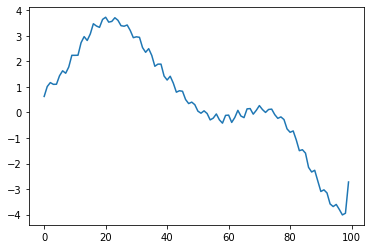
_T = 1000_t = np.arange(_T)/_T * 10_x = 1.5*np.sin(2*_t)+2*np.random.rand(_T)+1.5*np.sin(4*_t)+1.5*np.sin(8*_t)
plt.plot(_x)
import itstgcnclass Eval_csy:
def __init__(self,learner,train_dataset):
self.learner = learner
# self.learner.model.eval()
try:self.learner.model.eval()
except:pass
self.train_dataset = train_dataset
self.lags = self.learner.lags
rslt_tr = self.learner(self.train_dataset)
self.X_tr = rslt_tr['X']
self.y_tr = rslt_tr['y']
self.f_tr = torch.concat([self.train_dataset[0].x.T,self.y_tr],axis=0).float()
self.yhat_tr = rslt_tr['yhat']
self.fhat_tr = torch.concat([self.train_dataset[0].x.T,self.yhat_tr],axis=0).float()_node_ids = {'node1':0,'node2':1}
_FX1 = np.stack([_x,_x],axis=1).tolist()
_edges1 = torch.tensor([[0,1]]).tolist()
data_dict1 = {'edges':_edges1, 'node_ids':_node_ids, 'FX':_FX1}
data1 = pd.DataFrame({'x':_x,'x1':_x,'xer':_x,'xer1':_x})loader1 = itstgcn.DatasetLoader(data_dict1)dataset = loader1.get_dataset(lags=2)mindex = itstgcn.rand_mindex(dataset,mrate=0.7)
dataset_miss = itstgcn.miss(dataset,mindex,mtype='rand')dataset_padded = itstgcn.padding(dataset_miss,interpolation_method='linear')lrnr = itstgcn.StgcnLearner(dataset_padded)lrnr.learn(filters=16,epoch=10)10/10evtor = Eval_csy(lrnr,dataset_padded)lrnr_2 = itstgcn.ITStgcnLearner(dataset_padded)lrnr_2.learn(filters=16,epoch=10)10/10evtor_2 = Eval_csy(lrnr_2,dataset_padded)Psi
with plt.style.context('seaborn-white'):
fig, ax1 = plt.subplots(figsize=(40,15))
ax1.plot(_x,'k--',label='Observed Data',lw=3)
ax1.legend(fontsize=40,loc='lower left',facecolor='white', frameon=True)
ax1.tick_params(axis='y', labelsize=40)
ax1.tick_params(axis='x', labelsize=40)
ax1.set_ylim(-6,6)
plt.savefig('Ebayes_fst.pdf', format='pdf')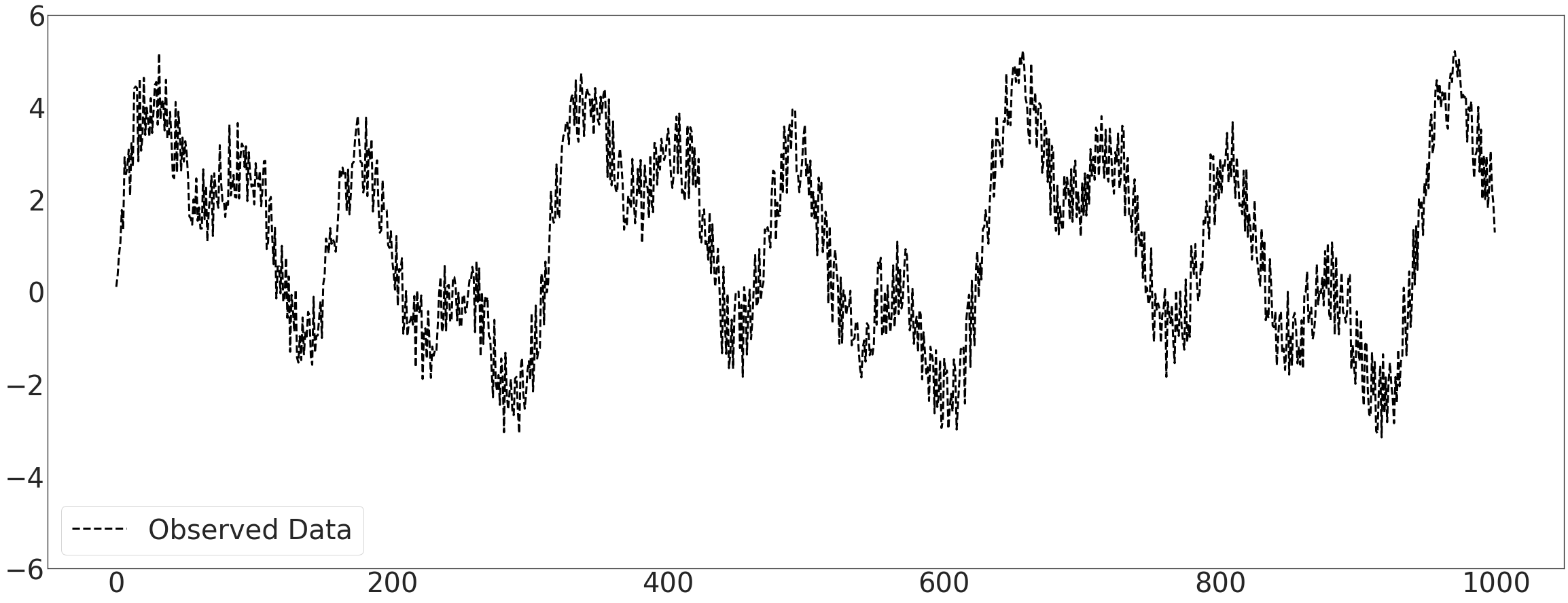
fourier transform
with plt.style.context('seaborn-white'):
fig, ax1 = plt.subplots(figsize=(40,15))
# ax1.plot(itstgcn.make_Psi(_T).T@np.array(_x),'-',color='C1',label='Fourier Transform',lw=3)
ax1.stem(itstgcn.make_Psi(_T).T@np.array(_x),linefmt='C1-',basefmt='k-',label='Fourier Transform')
ax1.legend(fontsize=40,loc='upper right',facecolor='white', frameon=True)
ax1.tick_params(axis='y', labelsize=40)
ax1.tick_params(axis='x', labelsize=40)
plt.savefig('Ebayes_snd.pdf', format='pdf')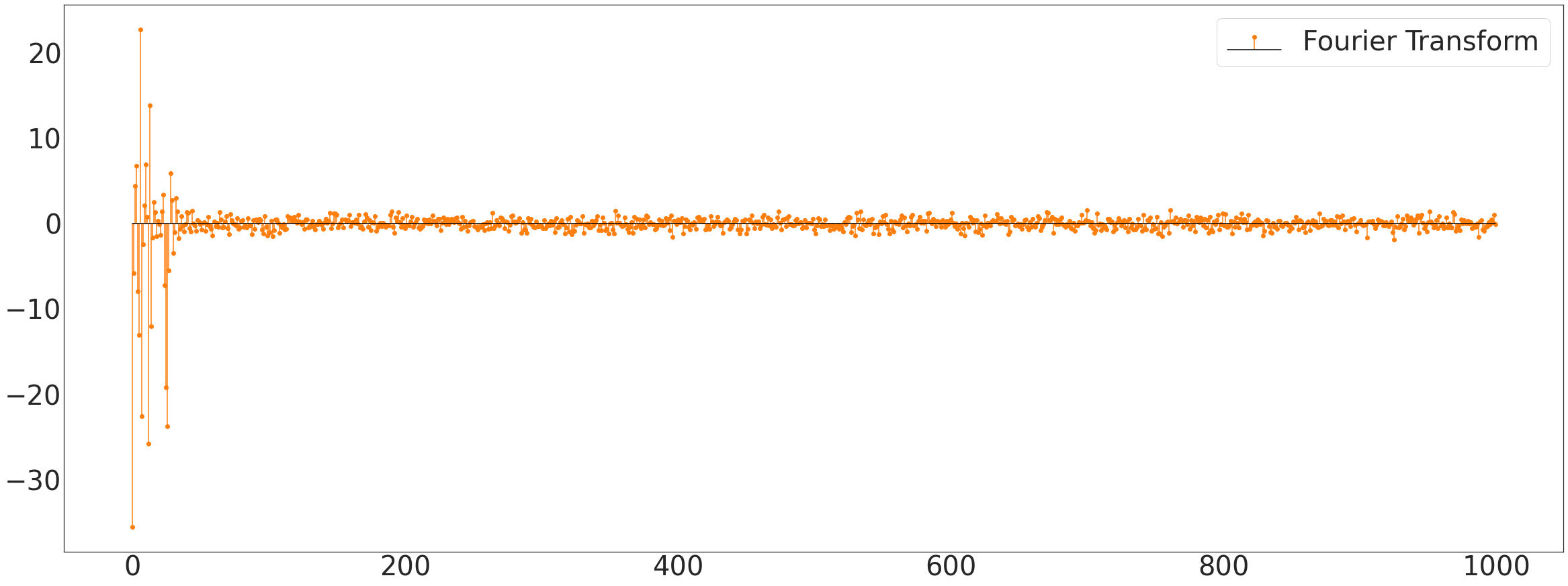
with plt.style.context('seaborn-white'):
fig, ax1 = plt.subplots(figsize=(40,15))
# ax1.plot(itstgcn.make_Psi(_T).T@np.array(_x),'-',color='C1',label='Fourier Transform',lw=3)
ax1.stem((itstgcn.make_Psi(_T).T@np.array(_x))[:100],linefmt='C1-',basefmt='k-',label='Fourier Transform')
ax1.legend(fontsize=40,loc='upper right',facecolor='white', frameon=True)
ax1.tick_params(axis='y', labelsize=40)
ax1.tick_params(axis='x', labelsize=40)
plt.savefig('Ebayes_snd_zin.pdf', format='pdf')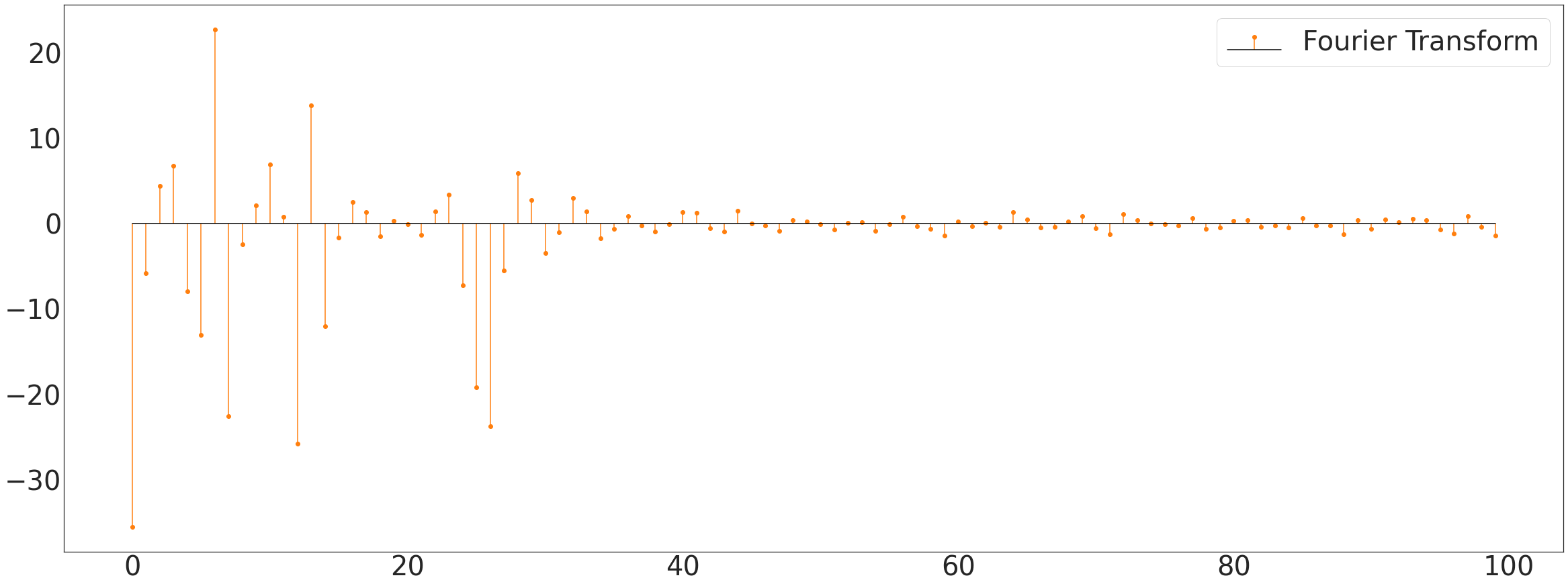
Ebayesthresh/trim
with plt.style.context('seaborn-white'):
fig, ax1 = plt.subplots(figsize=(40,15))
# ax1.plot(ebayesthresh(FloatVector(itstgcn.make_Psi(_T).T@np.array(_x))),'-',color='C1',label='EbayesThresh',lw=3)
ax1.stem(ebayesthresh(FloatVector(itstgcn.make_Psi(_T).T@np.array(_x))),linefmt='C1-',basefmt='k-',label='EbayesThresh')
ax1.legend(fontsize=40,loc='upper right',facecolor='white', frameon=True)
ax1.tick_params(axis='y', labelsize=40)
ax1.tick_params(axis='x', labelsize=40)
plt.savefig('Ebayes_trd.pdf', format='pdf')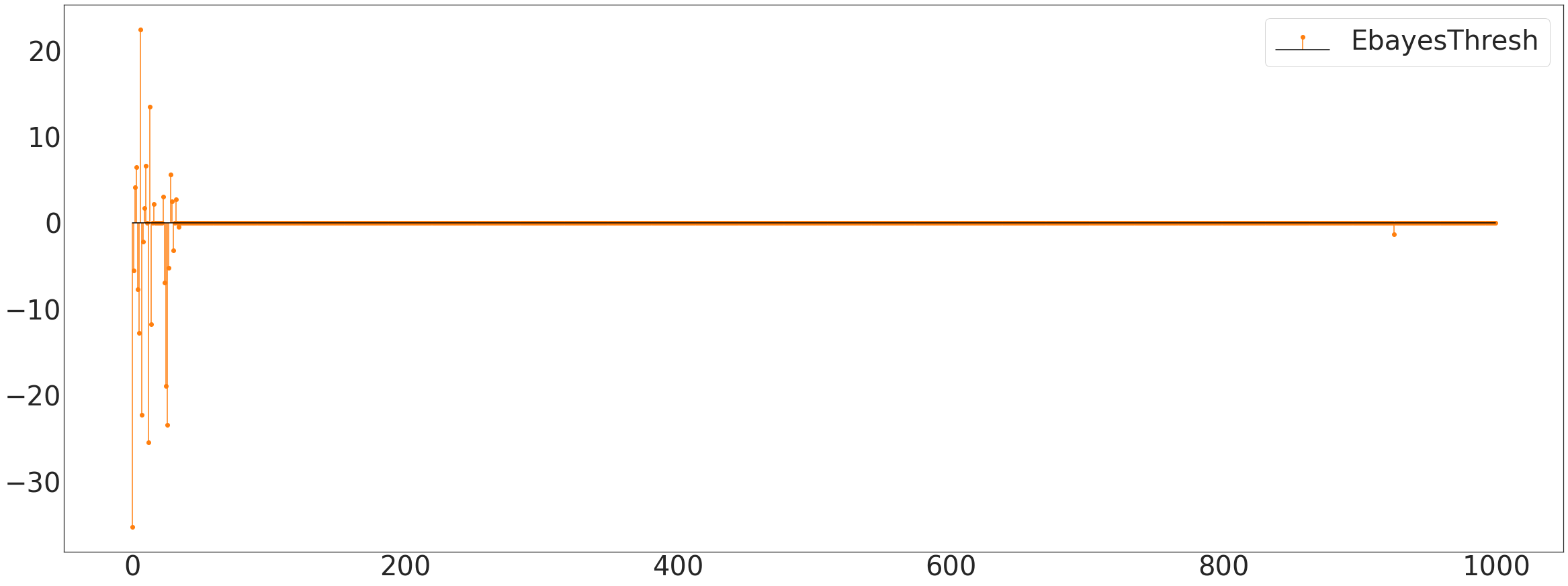
with plt.style.context('seaborn-white'):
fig, ax1 = plt.subplots(figsize=(40,15))
# ax1.plot(ebayesthresh(FloatVector(itstgcn.make_Psi(_T).T@np.array(_x))),'-',color='C1',label='EbayesThresh',lw=3)
ax1.stem((ebayesthresh(FloatVector(itstgcn.make_Psi(_T).T@np.array(_x))))[:100],linefmt='C1-',basefmt='k-',label='EbayesThresh')
ax1.legend(fontsize=40,loc='upper right',facecolor='white', frameon=True)
ax1.tick_params(axis='y', labelsize=40)
ax1.tick_params(axis='x', labelsize=40)
plt.savefig('Ebayes_trd_zout.pdf', format='pdf')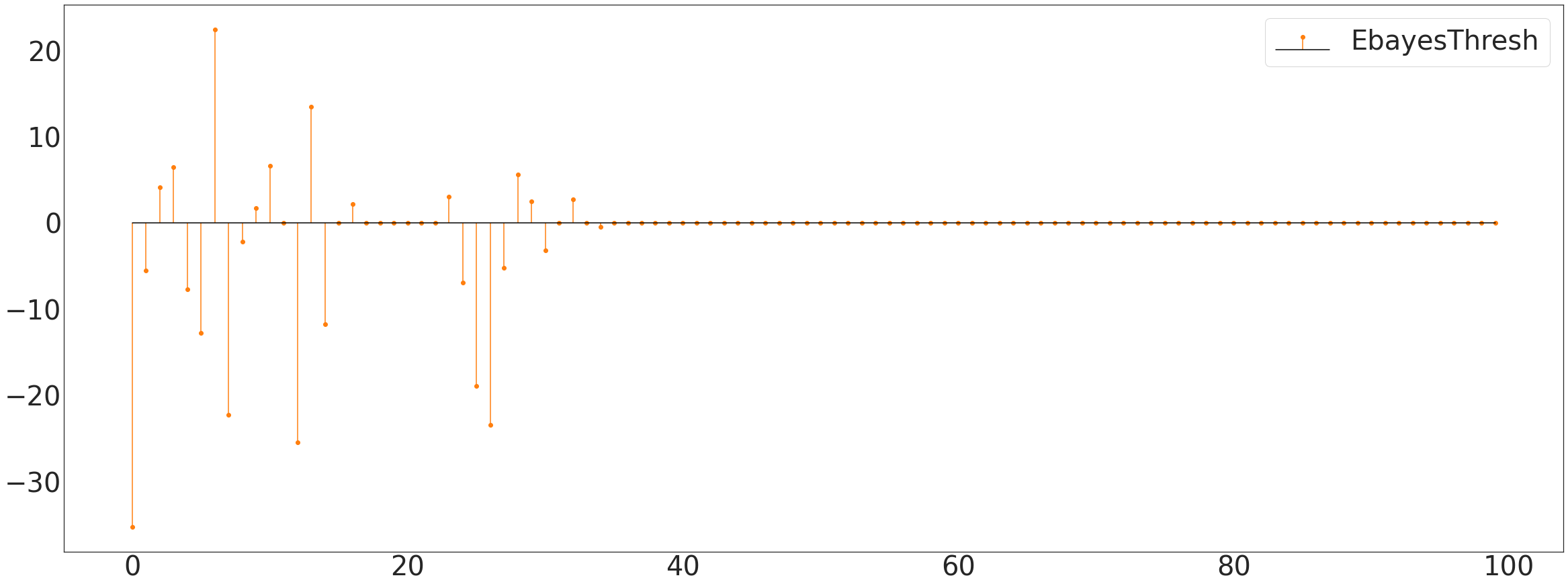
fhat
with plt.style.context('seaborn-white'):
fig, ax1 = plt.subplots(figsize=(40,15))
ax1.plot(_x,'k--',label='Observed Data',lw=3,alpha=0.3)
ax1.plot(itstgcn.make_Psi(_T)@ebayesthresh(FloatVector(itstgcn.make_Psi(_T).T@np.array(_x))),'-',color='C1',label='Inverse Fourier Transform',lw=5)
ax1.legend(fontsize=40,loc='lower left',facecolor='white', frameon=True)
ax1.tick_params(axis='y', labelsize=40)
ax1.tick_params(axis='x', labelsize=40)
ax1.set_ylim(-6,6)
plt.savefig('Ebayes_fth.pdf', format='pdf')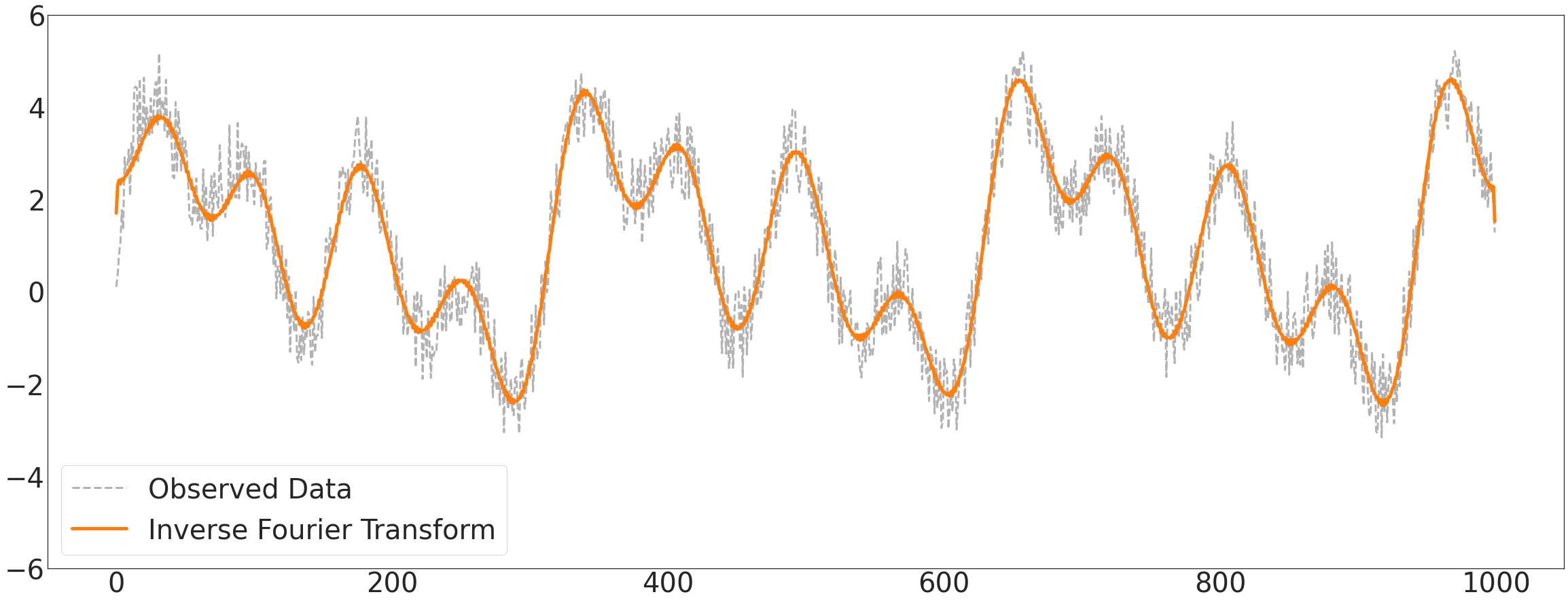
with plt.style.context('seaborn-white'):
fig, ax1 = plt.subplots(figsize=(40,15))
# fig.suptitle('Figure 1(node 1)',fontsize=40)
ax1.plot(data1['x'][:],'-',color='C3',label='Complete Data')
ax1.legend(fontsize=40,loc='lower left',facecolor='white', frameon=True)
ax1.tick_params(axis='y', labelsize=40)
ax1.tick_params(axis='x', labelsize=40)
# plt.savefig('node1_fst.png')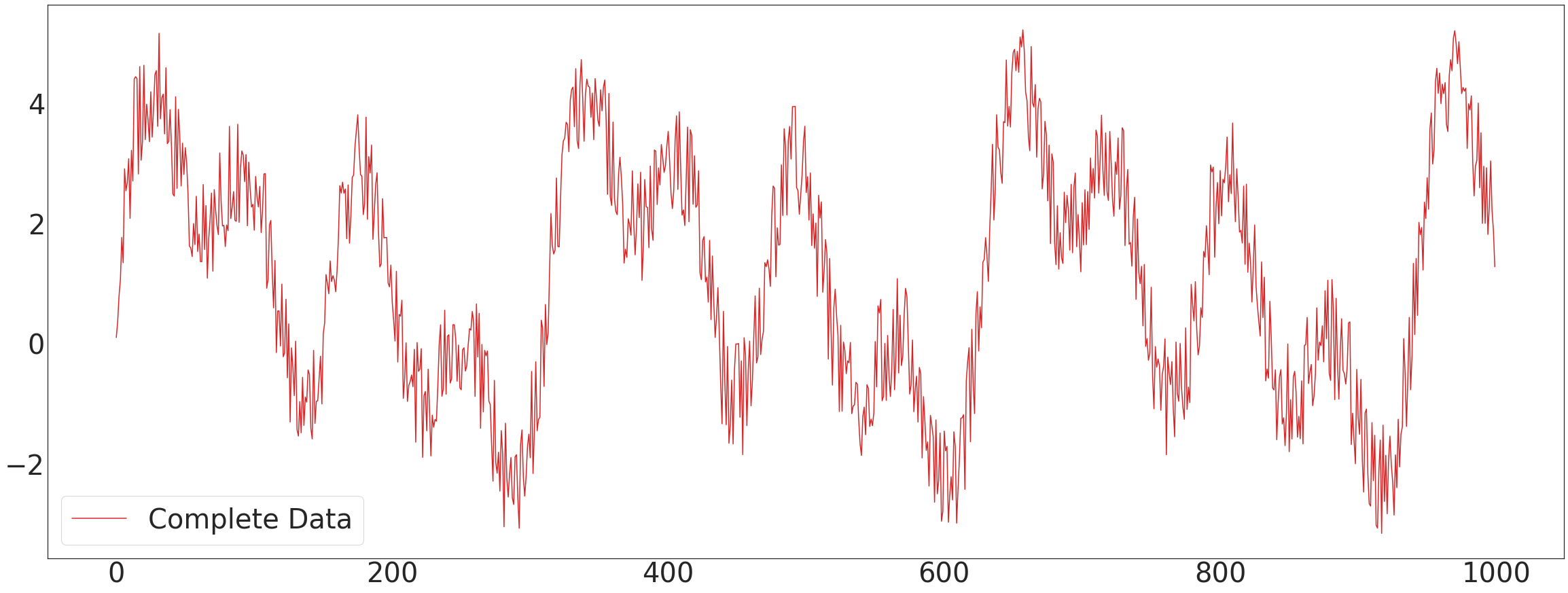
with plt.style.context('seaborn-white'):
fig, ax2 = plt.subplots(figsize=(40,15))
# fig.suptitle('Figure 1(node 1)',fontsize=40)
ax2.plot(data1['x'][:],'--',color='C5',alpha=0.5,label='Complete Data')
ax2.plot(torch.cat([torch.tensor(data1['x'][:4]),torch.tensor(dataset_miss.targets).reshape(-1,2)[:,0]],dim=0),'--o',color='C3',label='Observed Data',markersize=15)
ax2.legend(fontsize=40,loc='lower left',facecolor='white', frameon=True)
ax2.tick_params(axis='y', labelsize=40)
ax2.tick_params(axis='x', labelsize=40)
# plt.savefig('node1_snd.png')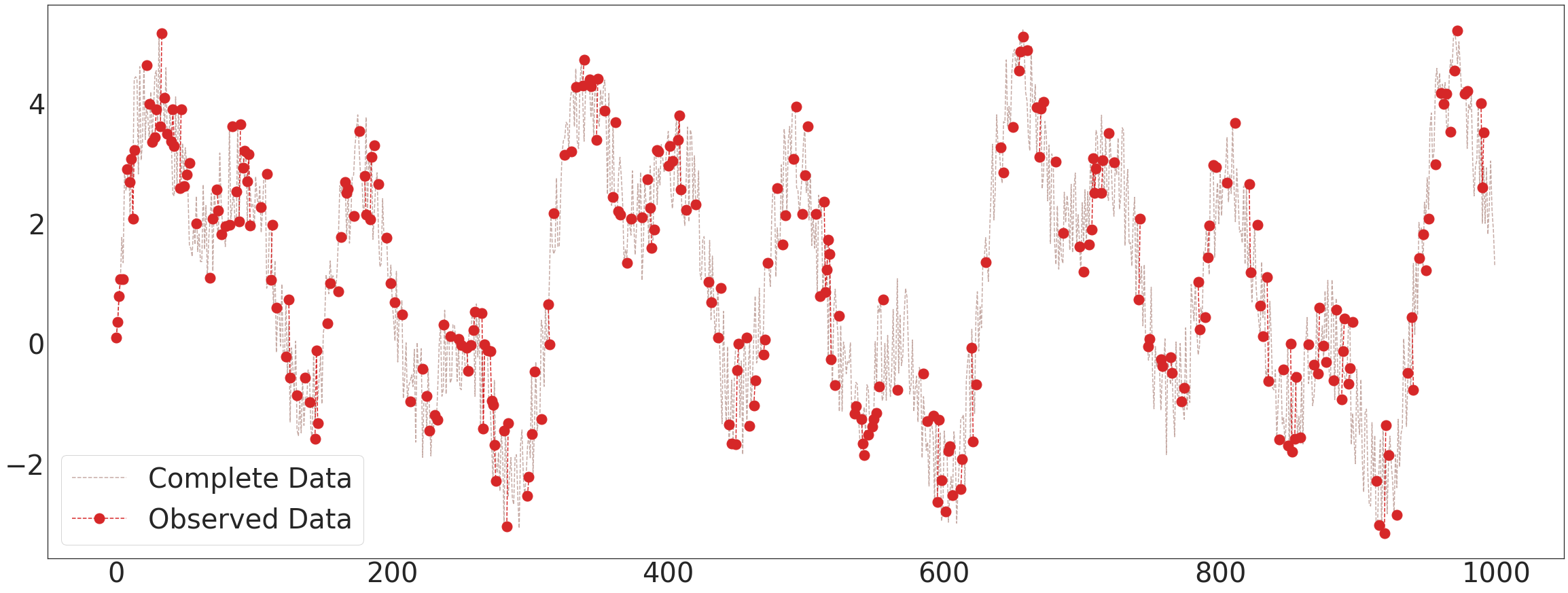
with plt.style.context('seaborn-white'):
fig, ax3 = plt.subplots(figsize=(40,15))
# fig.suptitle('Figure 1(node 1)',fontsize=40)
ax3.plot(data1['x'][:],'--',color='C5',alpha=0.5,label='Complete Data')
ax3.plot(evtor_2.f_tr[:,0],'--o',color='C3',alpha=0.8,label='Interpolarion')
ax3.legend(fontsize=40,loc='lower left',facecolor='white', frameon=True)
ax3.tick_params(axis='y', labelsize=40)
ax3.tick_params(axis='x', labelsize=40)
# plt.savefig('node1_3rd.png')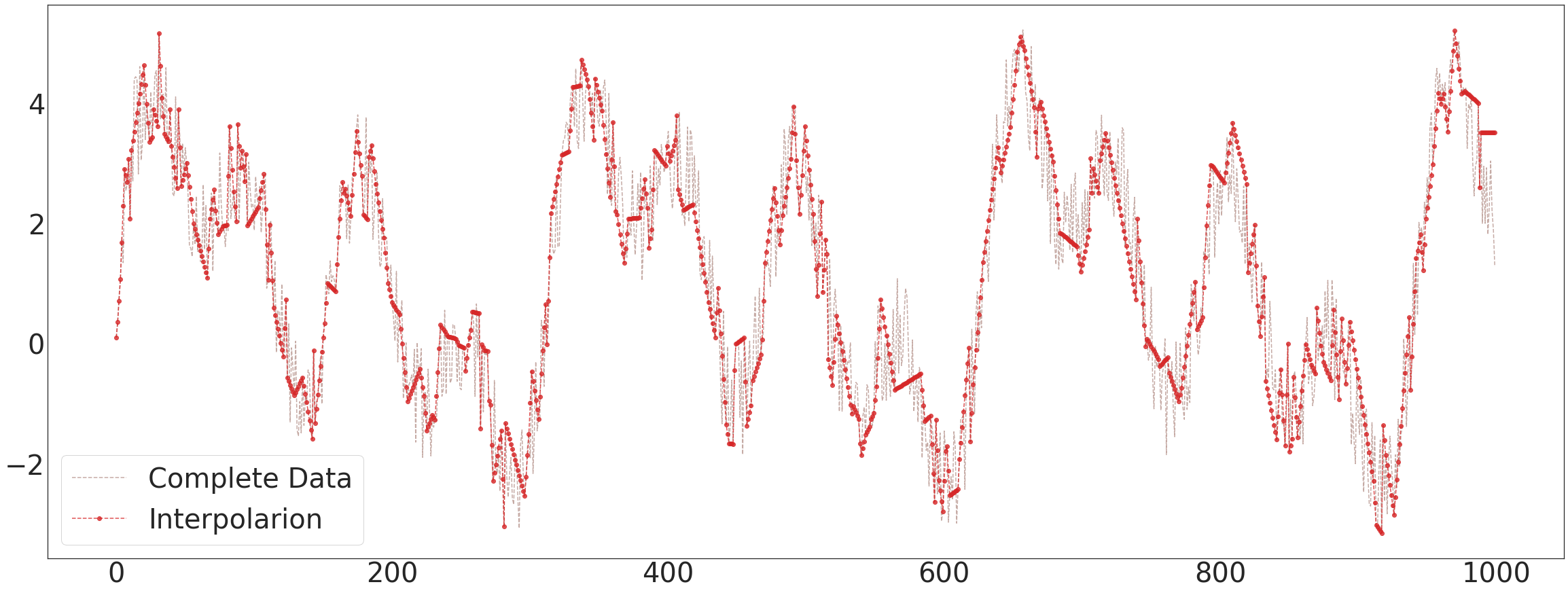
with plt.style.context('seaborn-white'):
fig, ax4 = plt.subplots(figsize=(40,15))
# fig.suptitle('Figure 1(node 1)',fontsize=40)
ax4.plot(data1['x'][:],'--',color='C5',alpha=0.5,label='Complete Data')
ax4.plot(evtor.fhat_tr[:,0],color='brown',lw=3,label='STGCN')
ax4.plot(evtor_2.fhat_tr[:,0],color='blue',lw=3,label='ITSTGCN')
# ax4.plot(138, -1.2, 'o', markersize=230, markerfacecolor='none', markeredgecolor='red',markeredgewidth=3)
# ax4.plot(220, -1.5, 'o', markersize=200, markerfacecolor='none', markeredgecolor='red',markeredgewidth=3)
# ax4.plot(290, -1.2, 'o', markersize=310, markerfacecolor='none', markeredgecolor='red',markeredgewidth=3)
# ax4.plot(455, -0.9, 'o', markersize=280, markerfacecolor='none', markeredgecolor='red',markeredgewidth=3)
ax4.legend(fontsize=40,loc='lower left',facecolor='white', frameon=True)
ax4.tick_params(axis='y', labelsize=40)
ax4.tick_params(axis='x', labelsize=40)
# plt.savefig('node1_4th_1.png')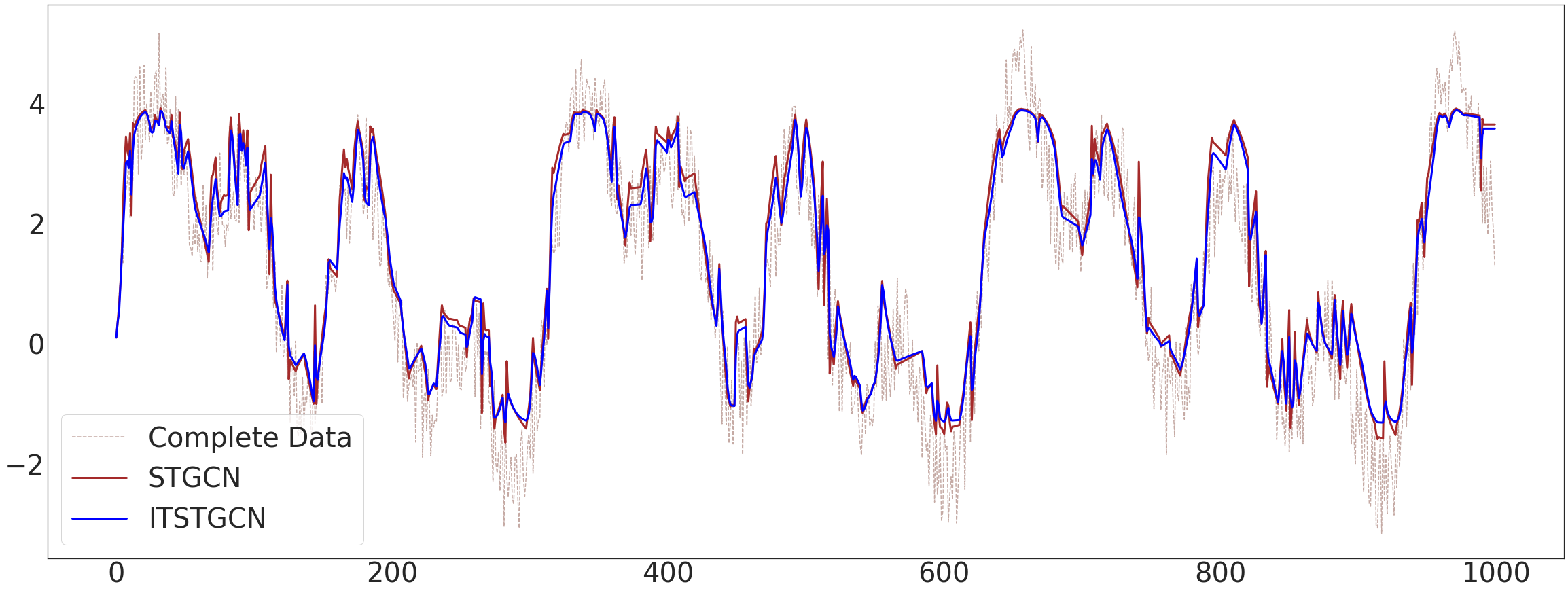
For Paper
T = 500t = np.arange(T)/T * 10y_true = 3*np.sin(0.5*t) + 1.2*np.sin(1.0*t) + 0.5*np.sin(1.2*t) y = y_true + np.random.normal(size=T)plt.figure(figsize=(20,10))
plt.plot(t,y_true,color='red',label = 'true')
plt.plot(t,y,'.',color='black',label = 'f')
plt.legend(fontsize=15,loc='lower left',facecolor='white', frameon=True)
# plt.savefig('1.png')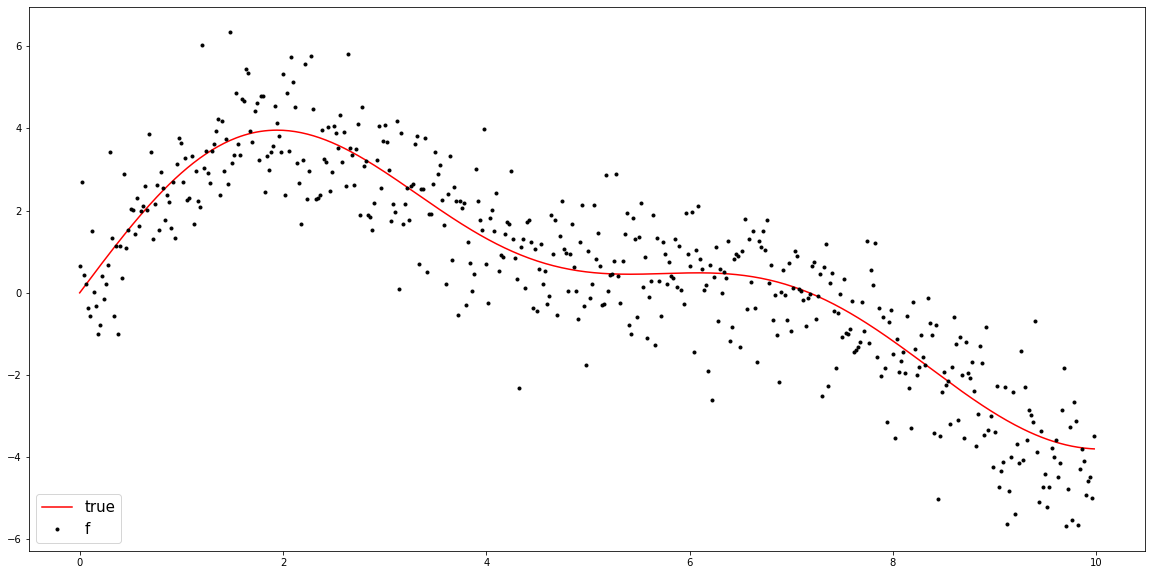
f = np.array(y)
if len(f.shape)==1: f = f.reshape(-1,1)
T,N = f.shape
Psi = make_Psi(T)
fbar = Psi.T @ f # apply dft fbar_threshed = np.stack([ebayesthresh(FloatVector(fbar[:,i])) for i in range(N)],axis=1)plt.figure(figsize=(20,10))
plt.plot(fbar**2,color='black')
# plt.savefig('1.png')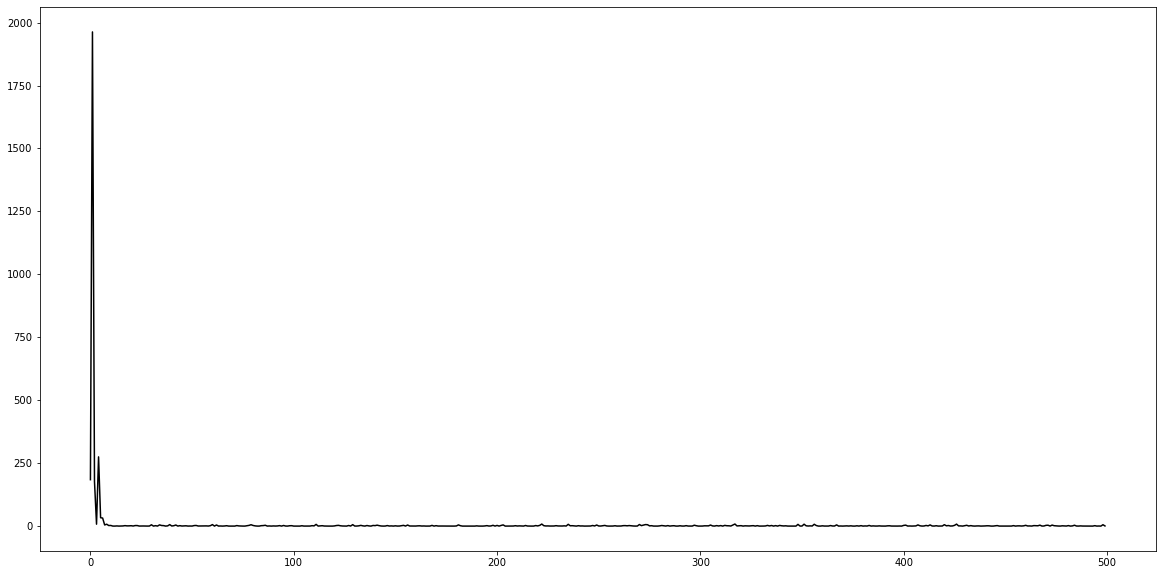
plt.figure(figsize=(20,10))
plt.plot(fbar_threshed**2,color='blue')
# plt.savefig('2.png')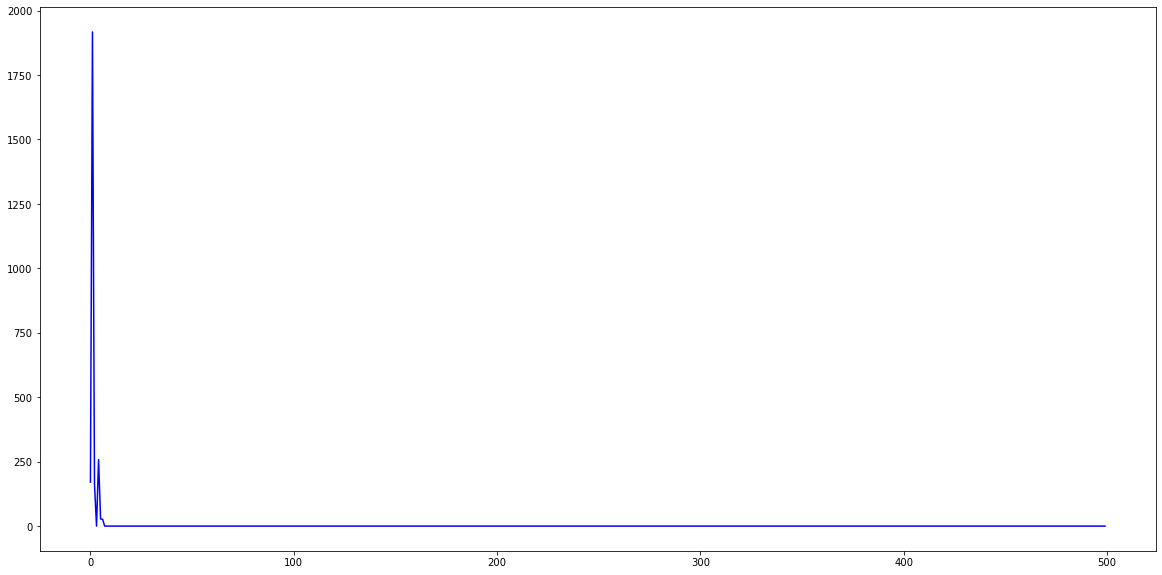
plt.figure(figsize = (20,10))
ax = plt.subplot(1, 1, 1)
ax.plot(range(0,500),(fbar**2),color='black')
ax.plot((fbar_threshed**2),color='blue')
axins = inset_axes(ax, 8, 3, loc = 1, bbox_to_anchor=(0.8, 0.8),
bbox_transform = ax.figure.transFigure)
axins.plot(range(100, 200),(fbar**2)[100:200],color='black')
axins.plot(range(100, 200),(fbar_threshed**2)[100:200],color='blue')
axins.set_xlim(100, 200)
axins.set_ylim(-0.1, 7)
mark_inset(ax, axins, loc1=4, loc2=3, fc="none", ec = "0.01")
ax.tick_params(axis='y', labelsize=20)
ax.tick_params(axis='x', labelsize=20)
axins.tick_params(axis='y', labelsize=15)
axins.tick_params(axis='x', labelsize=15)
# plt.savefig('3.png')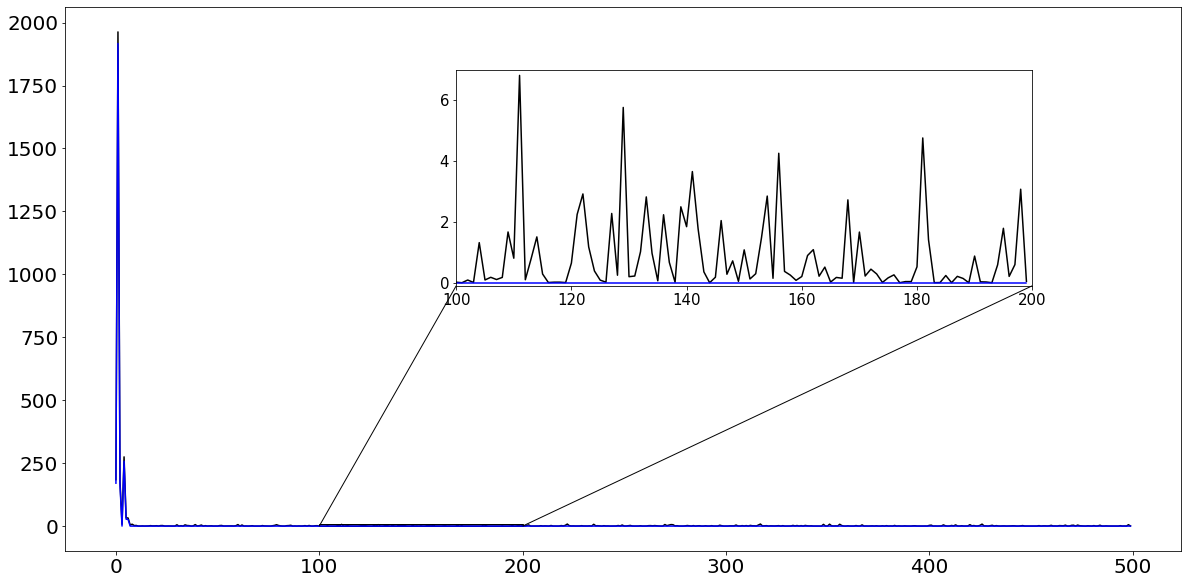
plt.figure(figsize=(20,10))
plt.plot((fbar_threshed**2),color='blue')
# plt.savefig('4.png')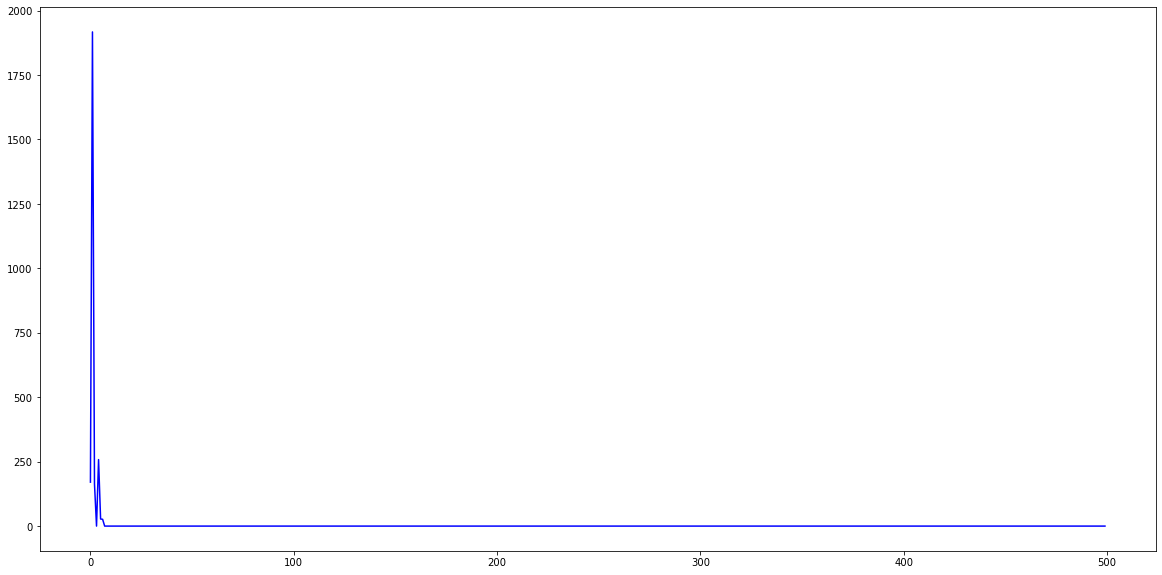
fbar_hat = Psi @ fbar_threshed # apply dft plt.figure(figsize=(20,10))
plt.plot(y_true,'r',label = 'True')
plt.plot(y,'k.',label='f')
plt.plot(fbar_hat,color='blue',label = 'fhat')
plt.legend(fontsize=15,loc='lower left',facecolor='white', frameon=True)
# plt.savefig('5.png')